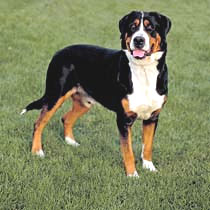|
The Canine Chronicles Directory
Greater Swiss Mountain Dog

Greater Swiss Mountain Dogs are the largest of the four Swiss varieties. The front
legs are straight and strong with rounded, compact feet. The head is large with
a broad, flat skull and slight stop. The skull should be the same length as the
muzzle. The muzzle is blunt, and the nose is black. The teeth should meet in a scissors
bite. The chest is broad and deep, and the breast bone extends slightly ahead of
the legs. The eyes are dark brown (blue eyes are a disqualification) with a gentle
but lively expression. The eye rims are black. The medium-sized ears are triangular.
The long tail reaches to the hocks and has a white tip. The Greater Swiss Mountain
Dog has a beautiful tri-color double coat (black with rich rust and white markings).
The outer coat is about 1-1¾ inches long, lined with a dense undercoat. Rust
markings include a spot over each eye, rust on the cheeks, and on either side of
the chest. The blaze on the muzzle and a large marking on the chest are white. A
white collar or patches on the neck are permitted. Any base color other than black
is a disqualification.
|
|
Temperament
|
The Swissy is a calm, even-tempered and sturdy dog. Not a roamer, they hate to be
tied or confined and are happiest with their family. He loves to pull carts or sleds,
especially if the passenger is a child. They are steady and protective but not aggressive.
He loves to please and is excellent with children. Territorial in nature, Swissy's
should be introduced to newcomers, but will warm up quickly. He will bark at strange
noises and at intruders. He prefers to be with his family at all times. Swissy's
get along well with family pets and should be taught not to chase. They are slow
to mature.
|
|
Height, Weight
|
Male Height: 25-28" ; Weight: 130-145 lbs.
Female Height: 23-27" ; Weight: 100-120 lbs.
|
|
Health Problems
|
Like most large breed dogs, they are prone to hip dysplasia and bloat. The GSMG
is also prone to distichiasis, a condition in which extra lashes grow along the
edge of the eyelid. Surgery may be necessary to correct this condition.
|
|
Living Conditions
|
Swissy's will do okay living in an apartment. They do best with a small yard. They
enjoy a cooler climate and can become uncomfortable during warmer weather.
|
|
Exercise
|
This breed is a working bred and needs moderate amounts of exercise. |
|
Life Expectancy
|
About 10-11 years
|
|
Grooming
|
The coat of this breed is easy to groom and only needs to be brushed weekly. This
breed is an average shedder.
|
|
Origin
|
The Greater Swiss Mountain Dog's origin can be traced back to the Swiss Alps. He
is the largest and probably the oldest of the four Sennenhund breeds including the
Appenzell Cattle Dog, Entlebuch Cattle Dog and the Bernese Mountain Dog. This breed
is thought to be descendants of Roman Mastiffs that were brought to the area more
than 2000 years ago. The four breeds differ in size but have similar markings. The
GSMD is known as "the poor man's horse" because of his natural drafting ability.
The GSMD lost favor and almost became extinct when the St. Bernard became popular.
Dr. Albert Heim rediscovered the Greater Swiss Mountain Dog in 1908 while he was
judging a dog show. He encouraged people to begin breeding programs which helped
to re-establish the breed. The breed is still fairly rare, even in Switzerland.
They are recognized by the AKC and the UKC.
|
|
Group
|
AKC Working, UKC Guardian Dog
|